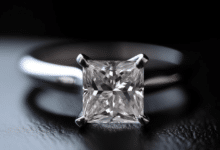15 Essential Princess Cut Diamond Terms Every Buyer Should Know

Diamonds have long been a symbol of love, commitment, and eternity, but when it comes to selecting the perfect princess cut diamond, the terminology can be overwhelming. With so many terms and jargon used in the jewelry industry, it’s essential for any prospective buyer to understand the language and what it means for their investment.
Whether you’re shopping for an engagement ring, an anniversary gift, or simply treating yourself, knowledge is power. By mastering these essential princess cut diamond terms, you’ll not only be able to navigate the buying process with confidence but also ensure that you’re making an informed and valuable decision.
1. Cut Quality
The cut of a diamond refers to the precise arrangement of the stone’s facets, which greatly impacts its overall beauty and brilliance. For princess cut diamonds, the terms you should be familiar with include:
- Ideal Cut: This denotes a diamond that has been cut to exacting proportions, optimizing its light performance and maximizing its sparkle.
- Depth Percentage: This refers to the height of the diamond relative to its width, typically ranging from 60% to 80% for princess cuts.
- Table Percentage: This describes the size of the diamond’s flat, top surface in relation to its overall width.
2. Clarity Characteristics
No diamond is truly perfect, and even the most exceptional stones may contain natural inclusions or blemishes. Understanding clarity terminology will help you assess the quality and value of a princess cut diamond:
- Flawless (FL): A diamond with no internal or external imperfections under 10x magnification.
- Internally Flawless (IF): A diamond with no internal inclusions but potential external blemishes.
- Very, Very Slightly Included (VVS1 and VVS2): Diamonds with minute inclusions that are difficult to detect under 10x magnification.
- Very Slightly Included (VS1 and VS2): Diamonds with minor inclusions that are slightly easier to detect under 10x magnification.
3. Color Grading
The color of a diamond is graded on a scale from D (colorless) to Z (light yellow or brown). The closer a stone is to the D range, the rarer and more valuable it is:
- D-F: Colorless diamonds, which are the rarest and most expensive.
- G-J: Near-colorless diamonds, which exhibit only slight tints of color.
- K-M: Faint yellow or brown tints become more noticeable.
- N-R: Very light yellow or brown tints are visible to the naked eye.
4. Carat Weight
The carat weight of a diamond is a measure of its size and mass, not its quality. However, larger diamonds are often rarer and more valuable. When discussing carat weight, you may encounter these terms:
- Total Carat Weight (TCW): The combined weight of all diamonds in a piece of jewelry.
- Center Stone: The main, largest diamond in a ring or other piece.
- Side Stones: The smaller diamonds surrounding the center stone.
5. Fluorescence
Fluorescence refers to the visible glow some diamonds emit when exposed to ultraviolet (UV) light. While not a factor in grading, understanding fluorescence can be helpful:
- None: No fluorescence is present.
- Faint: A slight glow is visible under UV light.
- Medium: A noticeable glow is present under UV light.
- Strong: A very intense glow is emitted under UV light.
6. Certification
Reputable diamond grading laboratories, such as the Gemological Institute of America (GIA) or the American Gem Society (AGS), provide independent certification for diamonds. These certifications, often called “diamond grading reports,” include detailed analyses of a stone’s cut, color, clarity, and carat weight.
By understanding these essential princess cut diamond terms, you’ll be well-equipped to navigate the world of fine jewelry and make an informed decision when purchasing your dream diamond. Remember, knowledge is power, and with the right terminology under your belt, you can confidently embark on your journey to finding the perfect princess cut diamond.












